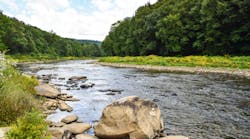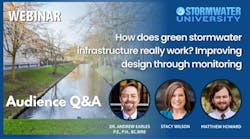OVERVIEW
Plant a tree, grow a business park. Two of the significant environmental challenges facing new construction projects are water conservation, and the handling of stormwater runoff to remove pollutants. In a recent project in College Park, Georgia, the two are solved together in an elegantly linked plan.
College Park, a small city on the southern border of the metropolis of Atlanta, wanted to redevelop an abandoned residential neighborhood into a viable commercial district. The neighborhood comprises a 16-block corridor west of Hartsfield Jackson Atlanta International Airport, the busiest airport in the world.
MISSING INFRASTRUCTURE
One of the first steps towards making the area attractive to businesses was to provide missing infrastructure. The neighborhood was very old. It had gas, water and sanitary sewer services, but no stormwater drainage system. The road surfaces were, not surprisingly, in terrible condition. In early 2009, College Park proposed a Low-Impact Development (LID) green solution to improve the area with a sustainable stormwater and irrigation system.
The proposal was two closely related projects, both of which enabled the city to make better use of stormwater runoff. The concept for the first phase, the neighborhood redevelopment, was to collect runoff from the streets of the 16-block corridor and pipe it to two large new sedimentation ponds comprising the Camp Creek Drainage Basin. Simultaneously, they would install a new irrigation water supply system to the corridor, which would draw water from the sedimentation ponds. This would reduce the city’s current expenses for bringing water in from another county. Engineering for both phases was done by Prime Engineering in Atlanta, Georgia.
BIOFILTRATION
For the heart of the stormwater management system, the city selected BioPod biofilters manufactured by Oldcastle Infrastructure. BioPod biofilters are open-bottomed box filters that remove suspended solids, petrochemicals and other pollutants using natural filtration methods. This treatment method enables the project to meet the 80% TSS (Total Suspended Solids) removal requirement in the Georgia Infrastructure Management Manual in a low-impact manner. More than 100 BioPod units were installed, making this one of the largest projects of its kind.
During a storm, the “first flush” of pollutant-heavy runoff – including oil and grease, bacteria, heavy metals, other suspended solids and large debris – enters the unit. As water moves through the system, suspended solids and pollutants are removed by settling and filtration. Large debris is collected on top of the mulch layer, under the grate, and can be easily removed by maintenance crews. In fact, maintenance consists largely of debris removal, and periodic replacement of the top mulch layer.
The College Park project used a simplified BioPod model. Typical units include a prefilter chamber and a bypass feature. The pre-filter collects large debris and keeps it out of sight until maintenance crews can remove it. The bypass is designed to handle high flows, eliminating the need for installing a separate high-flow bypass structure. Filtered water is collected by a geotextile-wrapped, 6-inch perforated pipe, and then carried out of the unit to the sedimentation ponds.
Editor's Note: Scranton Gillette Communications and the SGC Water Group are not liable for the accuracy, efficacy and validity of the claims made in this piece. The views expressed in this content do not reflect the position of the editorial teams of Water & Wastes Digest, Water Quality Products and Storm Water Solutions.







